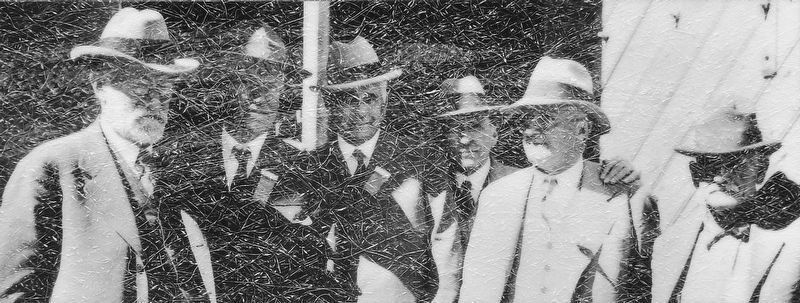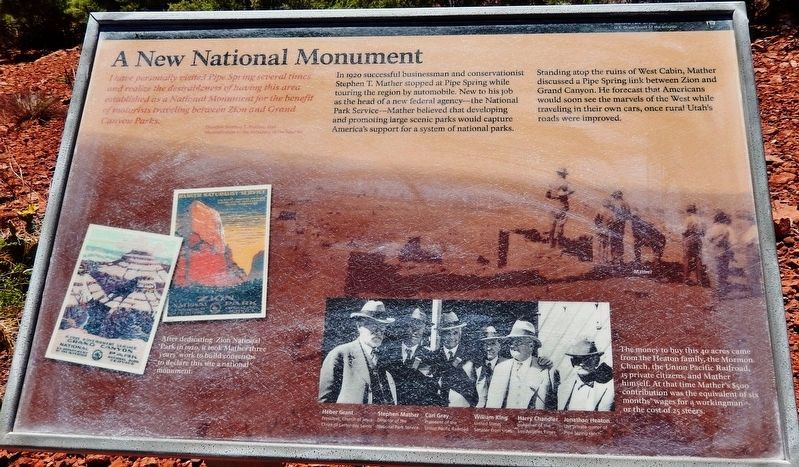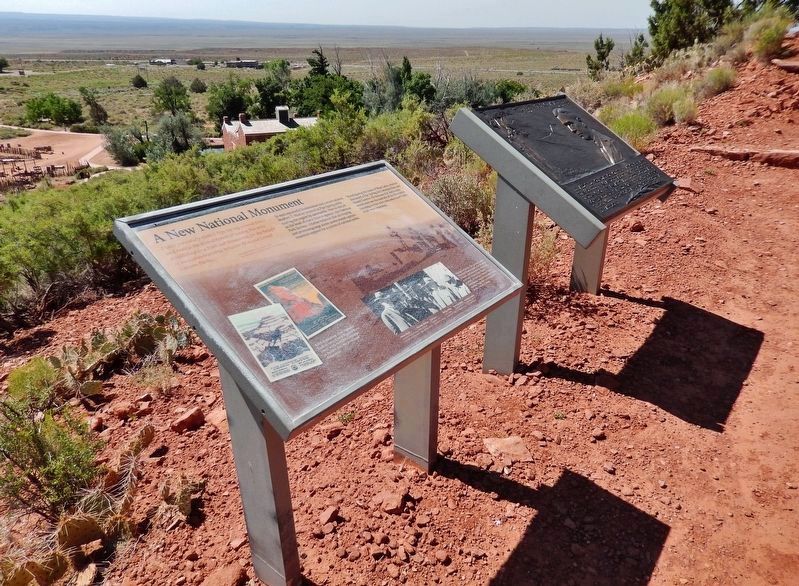Near Fredonia in Mohave County, Arizona — The American Mountains (Southwest)
A New National Monument
— Pipe Spring National Monument —
—Director Stephen T. Mather, 1920
Memorandum to the Secretary of the Interior
In 1920 successful businessman and conservationist Stephen T. Mather stopped at Pipe Spring while touring the region by automobile. New to his job as the head of a new federal agency — the National Park Service — Mather believed that developing and promoting large scenic parks would capture America's support for a system of national parks.
Standing atop the ruins of West Cabin, Mather discussed a Pipe Spring link between Zion and Grand Canyon. He forecast that Americans would soon see the marvels of the West while traveling in their own cars, once rural Utah's roads were improved.
The money to buy this 40 acres came from the Heaton family, the Mormon Church, the Union Pacific Railroad, 15 private citizens, and Mather himself. At that time Mather’s $500 contribution was the equivalent of six month’s wages for a workingman — or the cost of 25 steers.
After dedicating Zion National Park in 1920, it took Mather three years’ work to build consensus to declare this site a national monument.
Erected by National Park Service, U.S. Department of the Interior.
Topics. This historical marker and monument is listed in these topic lists: Charity & Public Work • Parks & Recreational Areas. A significant historical year for this entry is 1920.
Location. 36° 51.847′ N, 112° 44.411′ W. Marker is near Fredonia, Arizona, in Mohave County. Marker can be reached from North Pipe Spring Road, 0.3 miles north of Arizona Route 389, on the left when traveling north. Marker is located along the Ridge Trail in Pipe Spring National Monument. Touch for map. Marker is at or near this postal address: 406 North Pipe Spring Road, Fredonia AZ 86022, United States of America. Touch for directions.
Other nearby markers. At least 8 other markers are within walking distance of this marker. Stephen Tyng Mather (here, next to this marker); Skoomp (within shouting distance of this marker); Powell’s Surveyors at Pipe Spring (within shouting distance of this marker); How Can 10 Million Gallons of Water a Year Suddenly Appear in a Stony Desert? (about 300 feet away, measured in a direct line); Moamop' (about 300 feet away); Kwi'-uv (about 300 feet away); Oos'eev (about 300 feet away); Yoowuv' (about 300 feet away). Touch for a list and map of all markers in Fredonia.
Regarding A New National Monument. National Register of Historic Places #66000186.
Related markers.

2. Marker detail: Pipe Spring National Monument Supporters
Heber Grant
President, Church of Jesus Christ of Latter day Saints
Stephen Mather
Director of the National Park Service
Carl Gray
President of the Union Pacific Railroad
William King
United States Senator from Utah
Harry Chandler
Publisher of the Los Angeles Times
Jonathan Heaton
Last private owner of Pipe Spring Ranch
President, Church of Jesus Christ of Latter day Saints
Stephen Mather
Director of the National Park Service
Carl Gray
President of the Union Pacific Railroad
William King
United States Senator from Utah
Harry Chandler
Publisher of the Los Angeles Times
Jonathan Heaton
Last private owner of Pipe Spring Ranch
Also see . . .
1. Pipe Spring National Monument (Wikipedia). This isolated outpost served as a way station for people traveling across the Arizona Strip, that part of Arizona separated from the rest of the state by the Grand Canyon. It also served as a refuge for polygamist wives during the 1880s and 1890s. Although their way of life was greatly impacted by Mormon settlement, the Paiute Indians continued to live in the area and by 1907 the Kaibab Paiute Indian Reservation was established, surrounding the privately owned Pipe Spring ranch. In 1923, the Pipe Spring ranch was purchased and set aside as a national monument to be a memorial to western pioneer life. (Submitted on May 4, 2020, by Cosmos Mariner of Cape Canaveral, Florida.)
2. Pipe Spring National Monument. In May 1923, two months prior to his death, President Warren G. Harding declared the site a national monument to commemorate Western pioneer life. The National Park Service now maintains the ranch much as it was in its heyday, conducting guided tours and demonstrating dairy and other pioneer activities. The Ridge Trail winds up into the foothills behind the Castle and interpretive signs describe the area’s vegetation, geology, and history. (Submitted on May 6, 2020, by Cosmos Mariner of Cape Canaveral, Florida.)
Credits. This page was last revised on May 7, 2020. It was originally submitted on May 3, 2020, by Cosmos Mariner of Cape Canaveral, Florida. This page has been viewed 201 times since then and 24 times this year. Photos: 1, 2, 3. submitted on May 4, 2020, by Cosmos Mariner of Cape Canaveral, Florida.

